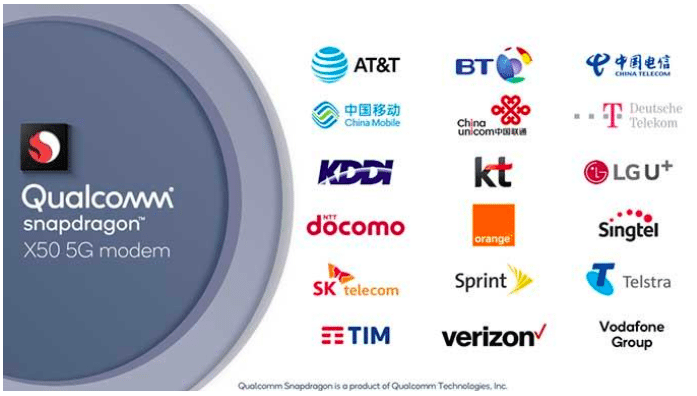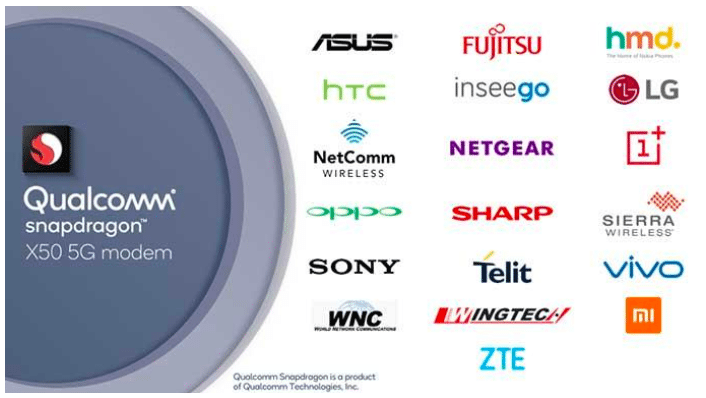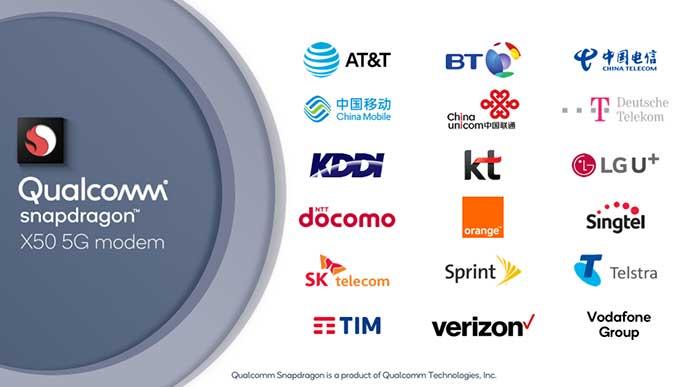Leading global operators and OEMs coalesce around the Snapdragon X50 5G modem for first wave of mobile 5G launches in 2019.

Last year, Qualcomm led a coalition of mobile industry leaders to answer the call for increased network capacity, to meet the ever-rising demands on mobile networks, by accelerating the timeline for 5G. Less than one year later, the first 5G NR global standard was approved by the 3GPP, bringing a new radio technology capable of efficiently delivering multi-gigabit-per-second data speeds at significantly lower latencies to usher in the next-generation of mobile user experiences. With that, the stage was set for real 5G NR mobile networks and mobile devices to be commercially available in 2019, or about one year after the standard was completed.
The journey from technical specifications on paper to working 5G devices and networks in the span of just over one year, is one whose path is beset by a multitude of challenges — challenges that put to test the mettle of all those involved across many vectors including fundamental R&D, silicon and radio engineering, systems integration and test, and even tactical coordination across geographic and regulatory boundaries.
The complexity involved in creating an entirely new language for devices and networks to communicate with each other is daunting. The challenge is all the more acute for 5G, specifically because of the lofty goals that the industry set for itself with this new generation: creating a unified connectivity fabric that will empower a host new of services and capabilities that simply have never existed before, and which will touch nearly every aspect of human endeavor. And yet, one that must comprehend the entire complexity of all previous generations that came before it.
But it is this level of complexity that allows true leaders to emerge, separating them from the laggards. The task of moving the world forward falls on the shoulders of a select group of companies that have the prowess, resources, and most importantly the sheer will to usher all of society into the next age of wireless connectivity.
Last week, Qualcomm Technologies and a group of the world’s leading mobile network operators and device OEMs made a declaration of exactly how far along we are in realizing this vision for 5G. And at the center of this progress lies the Qualcomm Snapdragon X50 5G modem — the world’s first announced 5G modem.

Beginning later this year, leading mobile network operators around the globe, in the US, China, Europe and Asia — including AT&T, Verizon, China Mobile, Deutsche Telekom, NTT DoCoMo, SK Telecom and many others — will begin the first trials of standards-compliant mobile 5G NR networks. And at the heart of the mobile test devices they will use to ascertain the performance of these emerging networks will be the Snapdragon X50 5G modem.
The trial phase for the launch of any cellular technology is of paramount importance. In essence, it will be the first time that “the rubber meets the road” for real 5G networks in the real world, not just in the lab. The insights gained from these mobile 5G NR trials will help both Qualcomm Technologiies and those operators (and their network infrastructure vendors) test and validate our collective 5G solutions, working in unison, to ensure that they perform as expected in time for broad availability to consumers in 2019.
Will there be 5G mobile devices in consumers’ hands to use on those networks? Nineteen leading OEMs are answering that question with a resounding “yes.” Leading Android smartphone makers including Samsung, LG, Sony, vivo, OnePlus, OPPO along with mobile data product makers including NETGEAR have chosen the Snapdragon X50 5G modem to power the first wave of true 5G NR products to hit the market.

All of this work on 5G is dovetailing with our collective efforts to strengthen the foundation for emerging 5G NR networks with a strong Gigabit LTE coverage layer, led once again by Qualcomm Technologies’ most advanced 4G modem announced to date — the Snapdragon X24 LTE modem.
And thus we have gone, in very short order, from speaking about 5G technology as a loose collection of ideas expressed in a myriad documents and presentations, to a concrete technology with a well-defined specification (which Qualcomm helped shape with several foundational inventions), working silicon and network infrastructure products, committed network trials, and ultimately 5G devices that consumers can look forward to.
5G is quickly transitioning from a technology on the horizon to a reality that’s only a few months away. It is an incredibly exciting time for the mobile industry, and just as we did in 3G and 4G, Qualcomm is playing a foundational role in leading the ecosystem together towards the realization of our 5G vision. If you plan on attending Mobile World Congress 2018, be sure to stop by our booth located in Hall 3, Stand 3E10.

